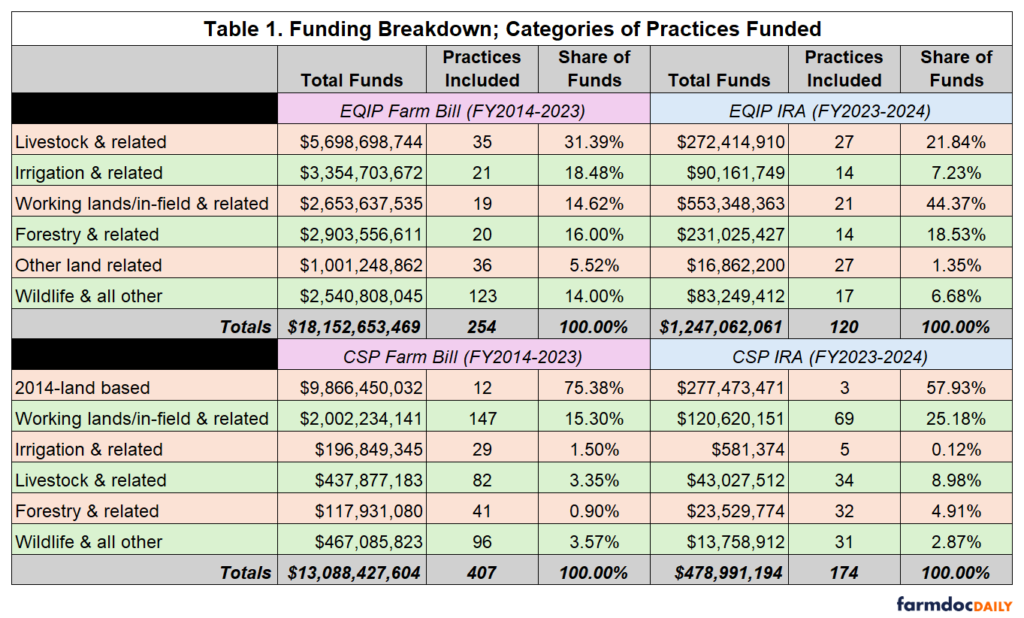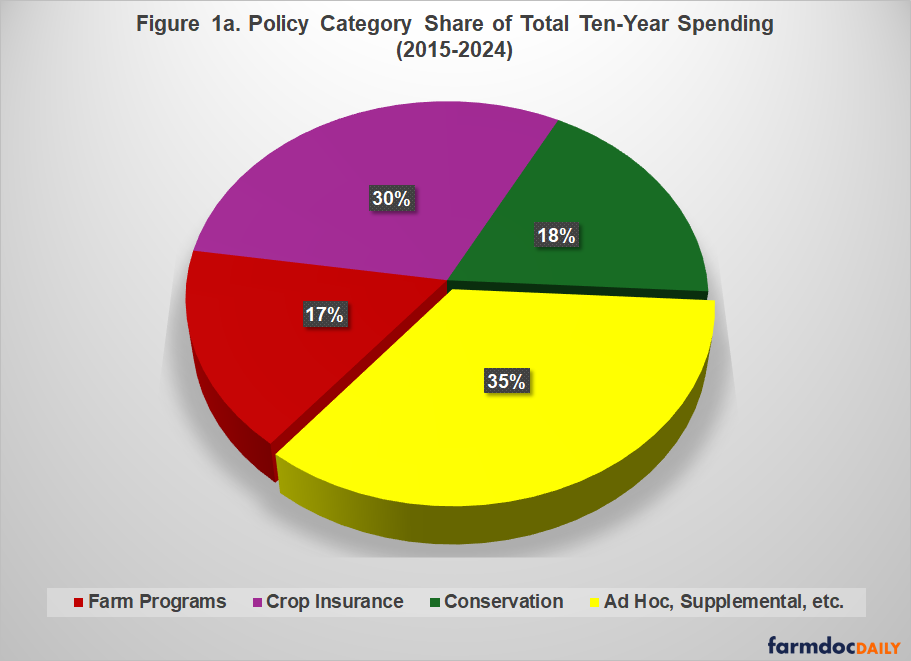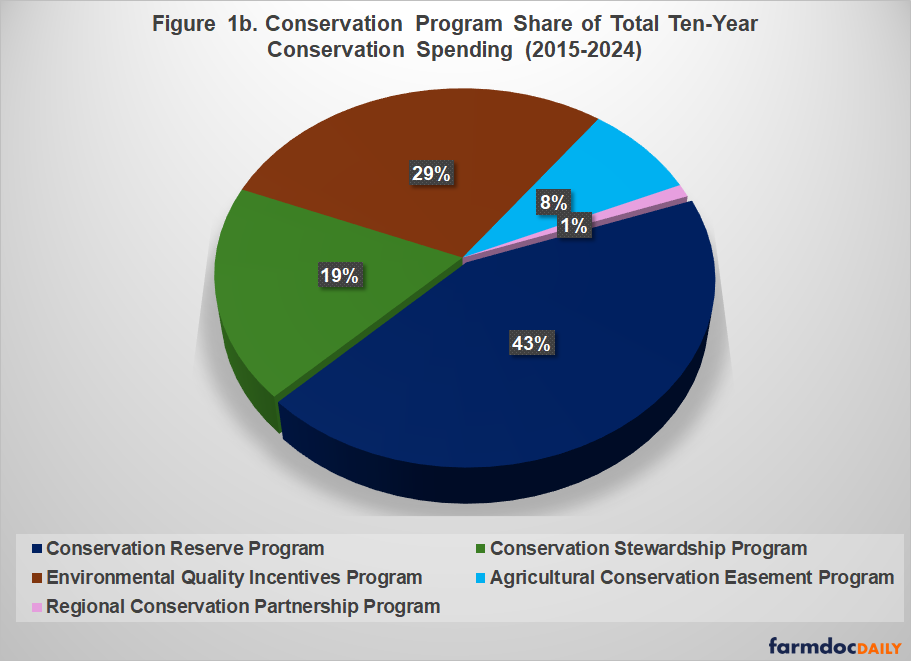Conservation Quandaries, Part 1: Too Much and Not Enough
The renowned psychologist Abraham Maslow observed in his 1966 book that “if the only tool you have is a hammer,” then the temptation is to “treat everything as if it were a nail” (Maslow, 1966, at 15; Esposito, 2015; McDonald, 2022). Known as “Maslow’s Hammer” (or the law of the instrument), it was inevitable that it would hit agricultural policy and of little surprise that the additional investments by Congress in the Inflation Reduction Act would among the first (Huffstutter and Douglas, February 8, 2025; Wu, Gupta, and Kaur, February 10, 2025; Hanrahan, February 10, 2025; Baethge, February 11, 2025; Held, February 11, 2025; Schwartz, February 10, 2025; Clayton, February 10, 2025; Miller and Edmondson, February 12, 2025). By comparison, the House and Senate Budget Committees have also initiated the budget and reconciliation process with initial resolutions calling for reductions by the Agriculture Committees of between $230 billion (House) and $1 billion (Senate) over the ten fiscal years 2025 to 2034 (House Budget Committee, February 12, 2025; Senate Budget Committee, February 7, 2025). On a Constitutional basis, the different approaches are critical and the manner in which the hammer is swung matters. For agricultural policy there are many additional questions, among them questions about conservation policy and the quandaries that afflict it. This article opens a series exploring the conservation quandaries seeking to extract lessons for policy design and beyond.
Background
It has been 11 years since the Agricultural Act of 2014 was signed into law, making significant changes to farm policy. Reviewing the most recent ten years, USDA data reports a total of $236.7 billion paid out to farmers through the Farm Bill (farm programs, conservation, and crop insurance) and ad hoc, supplemental or other assistance (USDA-RMA, USDA FSA, “ARC and PLC Data” and “Conservation Reserve Program (CRP) Statistics”, USDA-NRCS, USDA-ERS). Note that this amount does not include the $31 billion appropriated at the end of the lame duck 118th Congress (farmdoc daily, January 7, 2025). Figure 1a illustrates the share of this total assistance by program or Farm Bill title category and Figure 1b illustrates the share of the conservation spending (18% of the total) by program, including the Inflation Reduction Act spending for Agriculture Conservation Easement Program (ACEP), Conservation Stewardship Program (CSP), Environmental Quality Incentives Program (EQIP), and Regional Conservation Partnership Program (RCPP). The total reported IRA conservation spending for FY2023 and FY2024 ($2.1 billion) is about 5% of total conservation spending and less than 1% of total spending on farmers in these years.
The discussion below builds on previous efforts to analyze policy design with a focus on one of the primary issues for conservation: programs are limited in ways other policies are not, by either funding (EQIP, CSP, ACEP, and RCPP) or acreage (Conservation Reserve Program (CRP)) caps (see e.g., farmdoc daily, January 30, 2025; November 7, 2024; October 10, 2024; August 15, 2024; August 1, 2024; November 10, 2023; October 12, 2023). These caps or limits work to limit the policies’ effectiveness which, in turn, impacts their political support and strength. In a system of policymaking designed for competition, this weakening has real consequences (see e.g., farmdoc daily, January 5, 2023; January 26, 2023).
Discussion
It may come as little surprise that the IRA conservation funding is being targeted, but how it is undertaken matters profoundly; the difference between a Congressional process that deliberates on these matters in a public effort as intended in the Constitution, versus unilateral efforts lacking that imprimatur. Within that larger matter are the differences between changes to policies and funding going forward, versus the breaking of contracts and promises already made.
For conservation policy, IRA funds were focused on improving soil health and reducing nutrient losses, as well as addressing greenhouse gas emissions (see e.g., farmdoc daily, August 29, 2024). After two fiscal years of reported data on financial assistance allocated from the IRA appropriations, there is clear evidence of what is arguably the primary quandary for conservation policy: too few funds chasing too many practices; or, trying to do too much with too little. Digging into the reported data produces a dizzying array of different conservation practices that receive at least some funding—some as little as a few hundred dollars. In the Farm Bill, EQIP funds are divided among 254 different practices, while the IRA funds were divided among 120 different practices. CSP divides its smaller share of funding among more practices, 407 different practices (but including bundles, enhancements, etc. of practices) compared to 174 receiving some IRA funding. Table 1 provides a breakdown of the EQIP and CSP funding allocations using categories of practices based on the primary purposes of the practice. Many practices, it should be noted, have overlapping purposes or provide conservation benefits that would fit in multiple categories.
 The IRA presented an opportunity to help alleviate some conservation challenges, such as backlogs and the bardo for farmers (see e.g., farmdoc daily, September 28, 2023; Happ, April 2, 2024; Happ, September 9, 2021). It added more (but also limited) funding to oversubscribed and underfunded conservation programs ($18 billion) and it instructed USDA to limit the practices that could receive those funds. In operation, however, it has provided further proof of this primary quandary; the IRA funds were also allocated among many different practices, albeit fewer than Farm Bill funds. In general, there was little change in which practices received the most funding (farmdoc daily, October 10, 2024). EQIP and CSP funds, moreover, were allocated among the States little different than the Farm Bill (farmdoc daily, January 30, 2025).
The IRA presented an opportunity to help alleviate some conservation challenges, such as backlogs and the bardo for farmers (see e.g., farmdoc daily, September 28, 2023; Happ, April 2, 2024; Happ, September 9, 2021). It added more (but also limited) funding to oversubscribed and underfunded conservation programs ($18 billion) and it instructed USDA to limit the practices that could receive those funds. In operation, however, it has provided further proof of this primary quandary; the IRA funds were also allocated among many different practices, albeit fewer than Farm Bill funds. In general, there was little change in which practices received the most funding (farmdoc daily, October 10, 2024). EQIP and CSP funds, moreover, were allocated among the States little different than the Farm Bill (farmdoc daily, January 30, 2025).
Now that the IRA funding is under attack from both the Administration and Congress, an additional challenge is understanding critical differences in the ways those attacks are undertaken. In either outcome, conservation is likely to lose; more importantly, those farmers seeking the financial assistance to help their farms are likely to lose out on that assistance at a particularly difficult economic time. It is tempting, therefore, to wonder how much farmers and states could lose. Projections at this point, loaded with uncertainty, may miss the larger and more important issues, however.
The total funds appropriated for conservation in the IRA ($18 billion) were less than half what Congress appropriated for ad hoc and emergency supplemental assistance ($31 billion) in the lame duck session in December (farmdoc daily, January 7, 2025). The $10 billion of that package for assistance calculated based estimated economic losses for just the 2024 crop year is more than was appropriated to any single conservation program in the IRA over multiple fiscal years. This adds to a long history in which funding for conservation has been a much lower priority, or is quickly and too-easily sacrificed to other purposes (Coppess, 2024). For conservation policy, moreover, this lack of priority is compounded by the quandary highlighted in this discussion—limited conservation funds are expected to accomplish too much with too little, spread among too many practices to be effective. This, in turn, limits political support for the policy among farmers even as it maintains strong support among the general public (farmdoc daily, January 16, 2025). And, of course, taking money away from conservation does nothing to remedy these problems nor the challenges these policies were created to address.
Concluding Thoughts
Strange as it may seem, conservation’s quandaries hold lessons far beyond their purview. Policies that are tasked with doing too much with too little can become ineffective and weakened in the political competition. As a result, they are often the first to be hit by Maslow’s Hammer. It is a well-worn tactic to first attack that which is deemed weak or less important, accumulating power that can be expended upon the stronger and more powerful.
Fixating on what might be lost with the funds misses critical points and the differences are most important. The logical end of the Administration’s position on spending is to convert the Article I and Article III branches of the federal system into an advisory role to an all-powerful Executive; Congressional hearings and judicial rulings become little more than suggestions or pleas that can be easily ignored (see e.g., House Agriculture Committee, February 11, 2025; District of Rhode Island, February 10, 2025 and January 31, 2025; U.S. District Court, District of Columbia, February 3, 2025). It is a radical view, aspects of which are not new. David Stockman, President Reagan’s Director of the Office of Management and Budget (OMB) once wrote that Congress “would have to be reduced to the status of a ministerial arm of the White House” (Stockman, 1986, at 159 and 200). These are all views that are far from any logical reading of the Constitution, such as in the powerful opinion of former Supreme Court Justice Robert H. Jackson in 1952:
“When the President takes measures incompatible with the expressed or implied will of Congress, his power is at its lowest ebb, for then he can rely only upon his own constitutional powers minus any constitutional powers of Congress over the matter. Courts can sustain exclusive presidential control in such a case only by disabling the Congress from acting upon the subject. Presidential claim to a power at once so conclusive and preclusive must be scrutinized with caution, for what is at stake is the equilibrium established by our constitutional system” (Youngstown Sheet & Tube Co. v. Sawyer, 343 U.S. 579, 637-38 (1952)).
Considering this a Constitutional crisis also seems quaint; the Administration’s attack on spending presents a power play that threatens to eviscerate the Constitutional system entirely—the power of the purse is explicitly vested in Congress and is effectively the primary power (see e.g., Stith, 1988; White and Wildavsky, 1989; Wildavsky, 1988). The Administration, moreover, is operating under a vast and untested grant of Executive immunity (Trump v. U.S., 2024) and through an unelected and unappointed individual simply designated as a special government employee (see, Lipton and Grind, February 11, 2025; Lipton, February 5, 2025; Swan et al., February 4, 2025; Sanger, February 8, 2025). Consider, for example, that under the theory currently being tested this method of operation also means that the $10 billion ad hoc economic assistance appropriated by the previous Congress could be suspended, frozen, or eliminated, as could any other mandatory program in the Farm Bill.
In all of this there is both irony and portent. The acronyms of agencies or policies are beside the point. Fighting to save bits and pieces of one policy or the other—defending one interest’s funds over others—risks making profound mistakes. When ineffectiveness becomes ineffectual, hollow proclamations do little good. It is to focus on individual nails but miss the power that swings Maslow’s Hammer.
References
Baethge, Joshua. “Farmers demand answers on funding freeze.” Farm Futures. February 11, 2025. https://www.farmprogress.com/farm-policy/farmers-demand-answers-on-funding-freeze.
Clayton, Chris. “USDA Funding Freeze Hits REAP Projects.” DTN/Progressive Farmer. February 10, 2025. https://www.dtnpf.com/agriculture/web/ag/news/business-inputs/article/2025/02/10/small-businesses-farmers-financial.
Coppess, Jonathan. Between Soil and Society: Legislative History and Political Development of Farm Bill Conservation Policy (University of Nebraska Press, 2024). https://www.nebraskapress.unl.edu/nebraska/9781496225146/.
Coppess, J. "Federal Financial Assistance in Limbo; Farm Bill Perspective." farmdoc daily (15):18, Department of Agricultural and Consumer Economics, University of Illinois at Urbana-Champaign, January 30, 2025. https://farmdocdaily.illinois.edu/2025/01/federal-financial-assistance-in-limbo-farm-bill-perspective.html.
Coppess, J. "Conservation Tradeoff: Inflation Reduction Act vs. Baseline." farmdoc daily (14):150, Department of Agricultural and Consumer Economics, University of Illinois at Urbana-Champaign, August 15, 2024. https://farmdocdaily.illinois.edu/2024/08/conservation-tradeoff-inflation-reduction-act-vs-baseline.html.
Coppess, J. "Policy Design Case Study: EQIP and the Inflation Reduction Act." farmdoc daily (14):143, Department of Agricultural and Consumer Economics, University of Illinois at Urbana-Champaign, August 1, 2024. https://farmdocdaily.illinois.edu/2024/08/policy-design-case-study-eqip-and-the-inflation-reduction-act.html.
Coppess, J. "The Conservation Question, Part 9: The Arrested Development of the Conservation Security Program." farmdoc daily (13):206, Department of Agricultural and Consumer Economics, University of Illinois at Urbana-Champaign, November 10, 2023. https://farmdocdaily.illinois.edu/2023/11/the-conservation-question-part-9-the-arrested-development-of-the-conservation-security-program.html.
Coppess, J. "The Incredible Shrinking of the Conservation Stewardship Program." farmdoc daily (13):187, Department of Agricultural and Consumer Economics, University of Illinois at Urbana-Champaign, October 12, 2023. https://farmdocdaily.illinois.edu/2023/10/the-incredible-shrinking-of-the-conservation-stewardship-program.html.
Coppess, J. "Considering Congress, Part 3: A “Republican Remedy” to the Mortal Disease." farmdoc daily (13):2, Department of Agricultural and Consumer Economics, University of Illinois at Urbana-Champaign, January 5, 2023. https://farmdocdaily.illinois.edu/2023/01/considering-congress-part-3-a-republican-remedy-to-the-mortal-disease.html.
Coppess, J. "Considering Congress, Part 5: An Initial Critique of the Design." farmdoc daily (13):15, Department of Agricultural and Consumer Economics, University of Illinois at Urbana-Champaign, January 26, 2023. https://farmdocdaily.illinois.edu/2023/01/considering-congress-part-5-an-initial-critique-of-the-design.html.
Coppess, J. and Y. Peng. "Taking A Closer Look at the Conservation Tradeoff Issues." farmdoc daily (14):203, Department of Agricultural and Consumer Economics, University of Illinois at Urbana-Champaign, November 7, 2024. https://farmdocdaily.illinois.edu/2024/11/taking-a-closer-look-at-the-conservation-tradeoff-issues.html.
Coppess, J. and Y. Peng. "Conservation Tradeoff: EQIP in the Inflation Reduction Act and the House Farm Bill." farmdoc daily (14):185, Department of Agricultural and Consumer Economics, University of Illinois at Urbana-Champaign, October 10, 2024.
Crouch, Jeffrey, Mark J. Rozell, and Mitchel A. Sollenberger. "The law: The unitary executive theory and President Donald J. Trump." Presidential Studies Quarterly 47, no. 3 (2017): 561-573. https://doi.org/10.1111/psq.12401.
Davies, James Chowning. "Maslow and theory of political development: Getting to fundamentals." Political Psychology (1991): 389-420. https://www.jstor.org/stable/3791750.
Esposito, Robert T. "Charitable Solicitation Acts: Maslow's Hammer for Regulating Social Enterprise." NYUJL & Bus. 11 (2015): 463. https://papers.ssrn.com/sol3/papers.cfm?abstract_id=2512266.
Hanrahan, Ryan. “USDA Freezes Conservation, Other Direct Farmer Funding.” Farm Policy News. February 10, 2025. https://farmpolicynews.illinois.edu/2025/02/usda-freezes-conservation-other-direct-farmer-funding/.
Happ, Michael. “Costly versus cost-effective: How EQIP can be improved to serve more farmers and the climate.” Institute for Agriculture & Trade Policy. April 2, 2024. https://www.iatp.org/costly-versus-cost-effective.
Happ, Michael. “Closed Out: How U.S. farmers are denied access to conservation programs.” Institute for Agriculture & Trade Policy. September 9, 2021. https://www.iatp.org/documents/closed-out-how-us-farmers-are-denied-access-conservation-programs.
Held, Lisa. “Trump’s Funding Freeze Creates Chaos and Financial Distress for Farmers.” Civil Eats. February 11, 2025. https://civileats.com/2025/02/11/trumps-funding-freeze-creates-chaos-and-financial-distress-for-farmers/
Huffstutter, P.J. and Leah Douglas. “USDA freezes farmer funding for some programs, conservation contracts.” Reuters. February 8, 2025. https://www.reuters.com/world/us/usda-freezes-farmer-funding-some-programs-conservation-contracts-2025-02-08/.
Lipton, Eric. “Elon Musk Is a ‘Special Government Employee.’ What Does That Mean?” The New York Times. February 5, 2025. https://www.nytimes.com/2025/02/05/us/politics/elon-musk-special-government-employee-explainer.html.
Lipton and Grind. “Elon Musk’s Business Empire Scores Benefits Under Trump Shake-Up.” The New York Times. February 11, 2025. https://www.nytimes.com/2025/02/11/us/politics/elon-musk-companies-conflicts.html.
Maslow A.H. The Psychology of Science: A Reconnaissance (New York: Harper & Row 1966).
McDonald, William M. "The Problem With Maslow's Hammer." The American Journal of Geriatric Psychiatry 30, no. 12 (2022): 1324-1326.
https://www.ajgponline.org/article/S1064-7481(22)00439-0/fulltext
Miller, Maya C. and Catie Edmondson. “Republicans Love Trump’s Spending Cuts. Just Not in Their States.” The New York Times. February 12, 2025. https://www.nytimes.com/2025/02/12/us/politics/trump-spending-republicans-agriculture-research.html.
Paulson, N., G. Schnitkey, C. Zulauf and J. Coppess. "Impacts of Economic Assistance Payments." farmdoc daily (15):4, Department of Agricultural and Consumer Economics, University of Illinois at Urbana-Champaign, January 7, 2025. https://farmdocdaily.illinois.edu/2025/01/impacts-of-economic-assistance-payments.html.
Sanger, David E. “Musk Team’s Treasury Access Raises Security Fears, Despite Judge’s Ordered Halt.” The New York Times. February 8, 2025. https://www.nytimes.com/2025/02/08/us/politics/treasury-systems-raised-security-concerns.html.
Schwartz, Mattathias. “White House Failed to Comply With Court Order, Judge Rules.” The New York Times. February 10, 2025. https://www.nytimes.com/2025/02/10/us/trump-unfreezing-federal-grants-judge-ruling.html.
Stith, Kate. "Congress' Power of the Purse." Yale LJ 97 (1988): 1343. https://openyls.law.yale.edu/bitstream/handle/20.500.13051/16554/62_97YaleLJ1343_June1988_.pdf.
Stockman, David A. The Triumph of Politics: How the Reagan Revolution Failed (Harper & Row New York, NY 1986).
Swan, Jonathan, Theodore Schleifer, Maggie Haberman, Kate Conger, Ryan Mac, and Madeleine Ngo. “Inside Musk’s Aggressive Incursion Into the Federal Government.” The New York Times. Updated February 4, 2025. https://www.nytimes.com/2025/02/03/us/politics/musk-federal-government.html.
Trump v. United States, 603 U.S. ___ (2024). Available from Justia.com. https://supreme.justia.com/cases/federal/us/603/23-939/.
U.S. District Court for the District of Columbia. Memorandum Opinion and Order. February 3, 2025. https://storage.courtlistener.com/recap/gov.uscourts.dcd.276842/gov.uscourts.dcd.276842.30.0_5.pdf.
U.S. District Court for the District of Rhode Island. Order. February 10, 2025. https://storage.courtlistener.com/recap/gov.uscourts.rid.58912/gov.uscourts.rid.58912.96.0_5.pdf.
U.S. District Court for the District of Rhode Island. Temporary Restraining Order. January 31, 2025. https://storage.courtlistener.com/recap/gov.uscourts.rid.58912/gov.uscourts.rid.58912.50.0_2.pdf.
U.S. House of Representatives. Budget Committee. “Chairman Arrington’s Statement on the House Republicans’ Budget Blueprint.” February 12, 2025. https://budget.house.gov/press-release/chairman-arringtons-statement-on-the-house-republicans-budget-blueprint.
U.S. House of Representatives. Committee on Agriculture. “Examining The Economic Crisis in Farm Country.” Hearing. February 11, 2025. https://agriculture.house.gov/calendar/eventsingle.aspx?EventID=7839.
U.S. Senate. Committee on the Budget. “Chairman Graham Unveils FY2025 Budget Resolution To Secure The Border, Revitalize Our Military, Unleash American Energy Production and Begin The Process Of Restoring Fiscal Sanity.” February 7, 2025. https://www.budget.senate.gov/chairman/newsroom/press/chairman-graham-unveils-fy-2025-budget-resolution-to-secure-the-border-revitalize-our-military-unleash-american-energy-production-and-begin-the-process-of-restoring-fiscal-sanity.
White, Joseph and Aaron Wildavsky, The Deficit and the Public Interest: The Search for Responsible Budgeting in the 1980s (University of California Press, 1989).
Wildavsky, Aaron. The New Politics of the Budgetary Process (Glenview: Scott, Foresman, 1988).
Wu, Daniel, Gaya Gupta, and Anumita Kaur. “Farmers on the hook for millions after Trump freezes USDA funds.” The Washington Post. February 10, 2025. https://www.washingtonpost.com/nation/2025/02/10/farmers-agriculture-funding-frozen/.
Youngstown Sheet & Tube Co. v. Sawyer, 343 U.S. 579, 634 (1952) (Jackson concurring). Available from Justia.com. https://supreme.justia.com/cases/federal/us/343/579/#634.
Disclaimer: We request all readers, electronic media and others follow our citation guidelines when re-posting articles from farmdoc daily. Guidelines are available here. The farmdoc daily website falls under University of Illinois copyright and intellectual property rights. For a detailed statement, please see the University of Illinois Copyright Information and Policies here.









